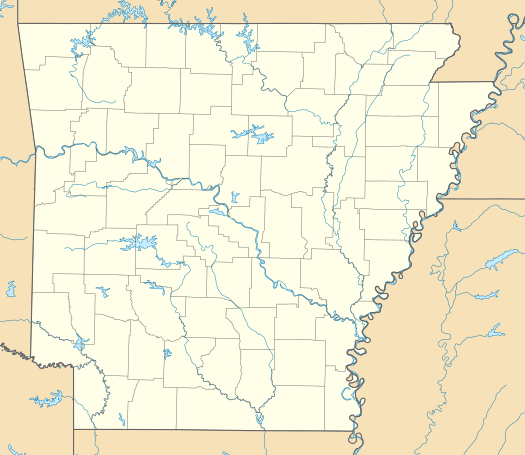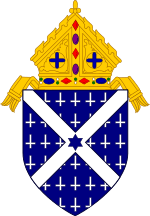Subiaco Abbey (Arkansas)
Subiaco Abbey is an American Benedictine monastery located in the Arkansas River valley of Logan County, Arkansas, part of the Swiss-American Congregation of Benedictine monasteries. The abbey and the preparatory school it operates, Subiaco Academy, are major features of the town of Subiaco, Arkansas. It is located within the Roman Catholic Diocese of Little Rock and is named after the original Subiaco Abbey in Italy, the first monastery founded by Saint Benedict.
Abbey cloister with a view of the Abbey Church | |
 Location within Arkansas  Subiaco Abbey (Arkansas) (the United States) | |
| Monastery information | |
|---|---|
| Other names | New Subiaco Abbey, St. Benedict Priory |
| Order | Benedictine |
| Established | March 15, 1878 |
| Mother house | St. Meinrad Archabbey (1878-1887), Einsiedeln Abbey |
| Dedicated to | St. Benedict of Nursia |
| Diocese | Little Rock |
| People | |
| Founder(s) | Dom Wolfgang Schlumpf, O.S.B. |
| Abbot | The Right Rev. Leonard Wangler, O.S.B. |
| Prior | Bro. Edward Fischesser, O.S.B. |
| Architecture | |
| Status | active |
| Functional status | abbey |
| Heritage designation | NRHP Ref. #78003484 |
| Designated date | February 28, 1978 |
| Groundbreaking | 1898 |
| Completion date | 1902 |
| Site | |
| Coordinates | 35.3011°N 93.6333°W |
| Website | www |
History
In 1877, the Little Rock and Fort Smith Railroad (LR&FS) owned thousands of open acres which it wished to settle. Deciding to offer land only to German Catholics, the company approached the Abbot of St. Meinrad Archabbey in Indiana, Martin Marty, O.S.B., with an offer for the establishment of a monastery and school to serve the German population it was bringing into the region.[1] The abbot negotiated with an agent of the railroad of a grant of 640 acres (2.6 km2) for the establishment of a Benedictine monastery for monks and an additional 100 acres (0.40 km2) for the foundation of a monastery for Benedictine nuns. This agreement received the support of Bishop Edward Fitzgerald, Bishop of Little Rock, who was in need of German-speaking priests for his diocese.
The original foundation was made on March 15, 1878, upon the arrival of three monk-missionaries from St. Meinrad Archabbey, Father Wolfgang Schlumpf, O.S.B., and two lay brothers. The foundation was named St. Benedict's Priory. Due to financial and personnel difficulties, St. Meinrad requested assistance. In the fall of 1887, its own founding monastery, Einsiedeln Abbey in Switzerland, assumed authority over the new foundation and sent eight novices and a priest-monk to Subiaco, Father Gall D'Aujourd'hui.[1]
In 1891 the monastery was raised to the status of an abbey by Pope Leo XIII, becoming independent of Switzerland, with the name being changed to the one the abbey currently has. The first abbot, Ignatius Conrad, O.S.B., a monk of Einsiedeln who was serving in Missouri, was elected in March 1892. Under his leadership, construction of a new abbey, made from local sandstone, was begun in 1898. In December 1901, just as the construction was nearing completion, the original wooden abbey, located about a mile away, burned to the ground and the monks transferred to the current site. This building was gutted by fire in 1927 and rebuilt. The third Abbot of Subiaco, Paul Nahlen, O.S.B., obtained Pope Pius XII's blessing for the construction of the present church on the campus. The church was completed in 1959.[1] This act is depicted in one of the 182 stained-glass frescoes in St. Benedict Abbey Church.
Over the years, the Benedictine monks at Subiaco have pursued various spiritual, agricultural, and commercial endeavors. First were missionary works, then the establishment of Subiaco Academy, a university-preparatory school. An overseas foundation was made in 1964 in Nigeria, but had to be closed in 1968, due to the Biafran War. A subsequent foundation, Santa Familia Priory was made in Belize in 1971.[1]
Monastery commercial endeavors
The abbey pursues the commercial cultivation of grapes and other fruits, cattle feed crops (hay), and stands of timber.
The abbey maintains an electronic commerce website where products made at the abbey are sold. These products consist primarily of candy (peanut brittle) and food seasonings, especially a habanero one termed "Monk Sauce".
For decades, the abbey maintained a dairy operation, but that effort was abandoned in 1964 with an open auction of the dairy cattle. Beginning in 1999, the abbey decided to make another attempt and began raising a registered herd of black Angus cattle, starting with cattle donations from local ranchers. The quality of the herd is carefully controlled with a program of artificial insemination. In 2001, the cattle operation became one of the first to begin a program of ultrasound of pregnant cattle, which enables close monitoring of the breeding program and the quick sale of bulls. The program reached a milestone in January, 2005, with the first sale of registered Angus cattle, bringing an average price of more than $5500 per animal.[2]
Coury House Retreat Center
Subiaco provides accommodation for friends of the abbey, family members of academy students, and in accordance with the Rule of St Benedict, anyone who comes in peace. Visitor accommodations are made at the Coury House Retreat Center, an hotel-like establishment on the campus that provides room and board to visitors—including married couples—who wish to experience the spiritual renewal and solitude of the Subiaco Abbey and campus.
Subiaco Academy
Subiaco Academy is a boarding/day school of Catholic tradition for any qualified young man in grades 7 through 12. It offers college preparatory classes, with co-curricular activities including sports, arts, and music and outdoor activities including hiking, camping, fishing, swimming, boating, water skiing, and kayaking.
The college placement rate for graduates is 100%. The academy's goal is to "challenge students to grow - mind, body and spirit."
Student body
The Academy has a diverse student body attracting international students mainly from South Korea and China. In the 2013-2014 school year there were students from 10 countries and 17 states. There are also students from Belize, Belarus, Mexico, Saudi Arabia, Curacao, Hong Kong, Taiwan, Russia, Nigeria, Angola, Spain, Thailand, Italy, Germany and Japan. In addition, the academy attracts students from across the United States.
Media references
KNWA-TV, a Fort Smith, Arkansas television station, produced a half-hour report on the history of the abbey and the academy in March 2009.[3]
Priests with credible allegations of molestation
On September 10, 2018 the Little Rock diocese released a report disclosing the names of clergy who at some time served in Arkansas and who have been credibly accused of child sexual abuse.[4] On January 24, 2020 the Abbey of Subiaco released a report disclosing the names of three deceased monks with established allegations of abuse: Nicholas Fuhrmann, Francis Zimmerer, and Patrick Hannon. Two additional deceased monks were listed as "Of Note": Fr. Timothy Donnelly for "multiple incidents of inappropriate touching" and Fr. Bede Mitchel as a "credible allegation of abuse" by the Diocese of Dallas (TX) which Subiaco could find no evidence. A criminal investigation is still pending on a former monk, Fr. Jeremy Myers, who left Subiaco Abbey to became a diocesan priest in the Diocese of Dallas (TX) in 1991.[5]
See also
- Subiaco, Italy
- Subiaco Abbey
- Einsiedeln Abbey
- St. Meinrad Archabbey
References
- "Subiaco History". Subiaco Abbey.
- Bennett, David (May 19, 2005). "Subiaco Abbey's Angus herd". Delta Farm Press. Archived from the original on February 28, 2010. Retrieved March 25, 2015.
- retrieved April 1, 2009
- "Bishop discloses credibly accused clergy | DOLR.org". Catholic Diocese of Little Rock. 2018-09-10. Retrieved 2018-11-07.
- "Subiaco discloses abusive monks | COUNTRYMONKS.org". Subiaco Abbey. 2020-07-09. Retrieved 2020-07-09.
External links
- Subiaco Abbey and Academy homepage
- "Guide to the New Subiaco Abbey Postcard and Prayer Card Collection", Collection of postcards depicting New Subiaco Abbey in Subiaco, Arkansas, housed in the University of Dayton's U.S. Catholic Special Collection.
